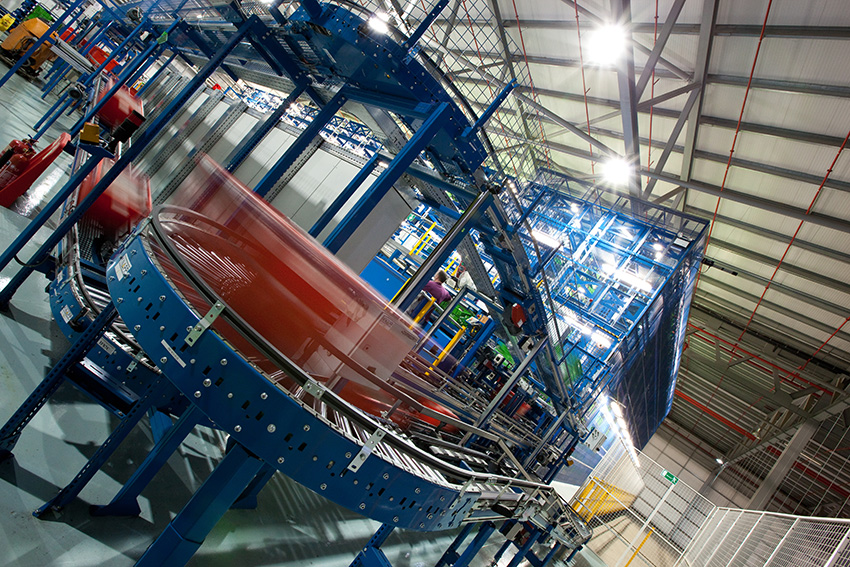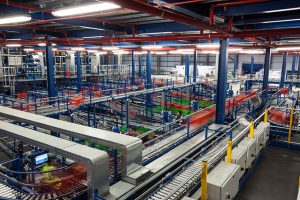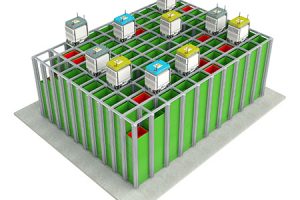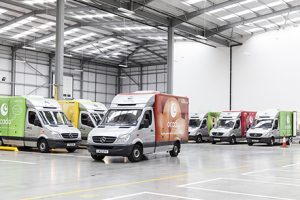 Many in automotive logistics like to think they’re at the cutting edge of automation and information technology. But as grocery e-retailer Ocado demonstrates, those in the car sector could learn a lot from the way other products are being handled and distributed
Many in automotive logistics like to think they’re at the cutting edge of automation and information technology. But as grocery e-retailer Ocado demonstrates, those in the car sector could learn a lot from the way other products are being handled and distributed
In this story...
It is hard to exaggerate the impact that digitalisation is having on the economy. In retailing, in the media, in engineering, the ability of both the internet and digital technology to transform markets and operations is extraordinary. Yet so far, the impact on logistics systems has been relatively modest. Barcodes still dominate data capture at the operational level while the underlying concepts have not changed much in several decades.
This is about to change, however.
Revolutionary modelsCompanies such as Ocado represent revolutionary business models, not only in terms of retailing but for the logistics sector more generally. Founded ten years ago by three former investment bankers, Ocado has been perceived as a fairly run-of-the-mill internet retailing business delivering upmarket groceries in the south of England. Its growth has been rapid but like many such businesses, its profit margins have been modest.
In the words of one big conventional retailer, shops are about “marketing and logistics”. But while the attention of investors may be on the grocery end of the business, the really exciting stuff is the powerful logistics model used behind the scenes at Ocado.
The most high-profile asset of a company like Ocado is its web presence. Like any internet business, this is the vital point of contact with its customers and it demands considerable investment to manage and develop, in terms of both time and money.
Ocado’s key physical assets, however, are its fulfilment centres, which it owns and operates itself. The first of these was established in Hatfield, just north of London, and it now has three in total: two in southern England and one in the Midlands. A fourth, in Essex, is soon to open.
These fulfilment centres are supported by its own in-house and dedicated network of trans-shipment hubs across the country, essential for supporting home delivery on such a scale. These warehousing facilities have been the driver of capital investment at Ocado and thus one of the main constraints on profitability.
Hatfield – still state-of-the-art[sta_anchor id="1"]The intensity of operations is significant. The Hatfield operation alone handles 150,000 orders a week, each one comprised of an average of 50 different items.

When introduced in the early 2000s, the Hatfield facility was revolutionary for grocery retailing; while it is not as advanced as more automated logistics operations that exist today (including at other Ocado sites), it still includes a number of state-of-the-art systems. It has also acted as a test bench for Ocado’s operational concepts.
Its fulfilment centres are dominated by picking operations and at first, the company had a fairly traditional set-up based around conventional picking stations. Goods were delivered to the fulfilment centre on pallets, stripped and placed adjacent to the picking station. Each picker was given an order to fulfil, with details of the SKUs (stock keeping units) to be included in each order communicated by a screen at each picking station. The tote box for each customer order was delivered to the picking station on a roller conveyor and the picker put the SKUs required from his zone into the tote, which then moved on to the next station. Stations were organised by type of product, including separate locations for frozen and chilled food. Data capture was all by barcode.
After several years, however, Ocado designed a new system based on feeding totes and trays directly into an automated racking system, which in turn fed individual SKUs to picking faces. The use of picking faces enabled each operator to pick a high proportion of any order without walking around racking in the traditional way to physically collect products. The implications for productivity were obvious.
Core to the whole operation is a large and sophisticated control tower. Conceptually not too different from other logistics operation, it is of a similar scale to the sort of facility found at a large global express delivery operator’s hub, with around 10-12 monitoring stations.
What is more important and impressive than the scale, however, is the visibility of information. Even within the older operations at Hatfield, the granularity of data resembles that seen at the huge logistics hubs of the likes of DHL Express and UPS, and is far greater than that of even the largest automotive assembly operation. The operation is predicated on an extensive barcode-based automated data capture system that allows the firm to visualise demand in real time, to locate every individual item in the warehouse or in transit, and to model response times.
[sta_anchor id="2"]The intensity of this data capture structure also reflects the demand for accuracy. Sid Shaikh, engineering R&D manager at Ocado and the man responsible for managing much of this change, says: “We can’t get our stock tracking wrong. It has to have very high accuracy as we simply can’t send the customer the wrong order.”
"We can't get our stock tracking wrong. It has to have very high accuracy as we simply can't send the customer the wrong order." - Sid Shaikh, Ocado
Building its own futureAs part of its second phase of development, Ocado had to begin to invest heavily in materials handling hardware and software. Rather than buying in existing systems and solutions, however, it chose to pursue its own tailor-made approach to logistics management, one based on the use of information technology and data rather than traditional warehouse practice. Consequently, Ocado created an in-house team of around 1,000 engineers to design the processes, equipment and software to deliver a number of bespoke logistics solutions.
This team was not just interested in digital issues, either. One good example is food products, including fruit and bread, which are packed in recyclable, grocery shop-style plastic bags before being placed in their respective tote boxes. Filing and placing them inside totes can be a hugely time-consuming activity. Ocado collaborated with a materials handling equipment manufacturer to create a bespoke machine to handle this, resulting in a big jump in productivity.
[sta_anchor id="3"]Use of new technology is, however, a key tenet of Ocado’s dramatically different approach to logistics, which is based on a belief in the potential for digital technology not just to solve problems but transform the business. As Sid Shaikh observes: “We don’t think of ourselves as a retail company; we are a technology company doing retail.”
‘Smart hive’ storageA good example of Ocado’s innovative approach in technology terms can be found at its newly opened, third fulfilment centre in Andover, in the south of England.
At the centre of the new facility is an automated warehousing system which Ocado describes as its ‘smart hive’ – essentially a block of racking that holds tote boxes. This racking area has no traditional aisles or access points; instead, totes are accessed from the top of the cube by robot handling devices, which pass over the racking, collecting an individual box from the cube and depositing it on a roller conveyor that takes it to a picking station. Once individual products have been picked, the tote is returned to the smart hive.
This solution provides fast, accurate access to stock as well as being highly efficient in terms of space. Human labour has been reduced, with the machines doing all the heavy lifting.
The concepts underlying the management of inventory at Andover are just as revolutionary, too.
Normally, any storage area would be arranged by demand for individual SKUs with separate zones for fast-moving, intermediate and slow-moving stock. But instead, Ocado has sought to use artificial intelligence to manage inventory. The managers who designed the system describe stock as entering the hive in a ‘wave’, with it subsequently arranged by an AI-created model of that day’s demand.
Information on demand is analysed by Ocado’s demand-modelling programmes and a daily schedule of products is ordered from suppliers, based on the results. The various items of stock are then distributed around the smart hive in a pattern which the programme estimates will be the sequence of demand. That means a slow-moving item may be stored at any location within the smart hive, as long as the demand-modelling programme thinks it is optimal for the time and location of the order.
 Items are stored in the smart hive in positions that should best serve the estimated sequence of demand
Items are stored in the smart hive in positions that should best serve the estimated sequence of demandThe designers of the system describe this as a ‘dynamic’ approach to inventory management that can adapt to fluctuations in the volume and nature of demand far more effectively than traditional approaches. Not only is there more information flowing into the system as a result of the internet-based relationship between Ocado and its customers, but the use of AI delivers a better forecast of demand, too. The result is, according to the retailer, a quality of inventory management that surpasses conventional methods both in terms of stock availability and speed of access.
Gathering the dataInformation generation is vital in such a system, of course, and Ocado uses a string of data capture locations based on both barcode information and item weight to ensure the system’s accuracy. In addition, every tote moving through the system is photographed to ensure service integrity.
One side-effect of this approach is a very dense volume of data passing across the facility, for which Ocado collaborated with engineers at Cambridge Consultants to create one of the densest 4G networks in the world, allowing communication with all of the different parts of the system within the Andover site.
In the longer term, there is a distinct likelihood of fully automated picking activity, too. Already, Cambridge Consultants has been working on robot hands capable of grasping even delicate items such as fruit. However, as Shaikh points-out, working with food items in an environment of such high throughput is very demanding, so implementing automation in picking operations, he admits, will be “tricky”.
Lesson in logisticsWhat Ocado has got right in its approach is its focus on information. One the most important aspects of its supply chain is that its relationship with customers is solely channelled through its website. This delivers a level of clarity about its customers’ behaviour that conventional retailers would find difficult to achieve.
The flow of data is of such quality and quantity that it can transform areas such as the management of inventory, as well as fixed assets. Compared to the sort of data-flow that vehicle manufacturers’ assembly operations achieve, the level of visibility is extraordinary – especially given that this is an operation with over 48,000 SKUs and an order-to-delivery cycle measured in hours, as well as handling 150,000 consignments a week from just one facility. Contrast the ability to create ‘build-to-order’ product when the producer has data on real-time demand surging through the system with the reliance on guesswork of most automotive dealerships and sales organisations.
 All the technology is designed to ensure that Ocado does not dispatch the wrong orders to its customers
All the technology is designed to ensure that Ocado does not dispatch the wrong orders to its customers[sta_anchor id="4"]The hardware is also powerful, of course: the smart hive concept, for instance, has gone some way to re-inventing warehousing operations. It offers a flexible, high-productivity solution to high-volume, high-performance logistics markets. The reduction in property requirements alone provides a significant reduction in fixed costs. It also begins to tackle the difficulty of integrating humans into such intense systems.
A future service providerOcado already manages the internet retailing operations of other companies, including fellow British grocery retailer Morrisons, and wants to expand this service offering, possibly outside the UK. Yet this is only the beginning, as far Ocado is concerned. It also wants to offer its ‘Ocado Smart Platform’ as a plug-in capability for any company looking for a high performance logistics capability.
“This is a massive opportunity,” says Shaikh. “We have the most advanced logistics facility in the world because we understand what the market needs as well as the technology itself.”
This would be a unique offering in the contract logistics market, with the potential for an entire sub-strategic logistics system to be made available to clients
Ocado is convinced that technology like the smart hive is highly scalable and could fit into much smaller facilities if necessary. Being part of a wider IT platform with extensive transport operations, it can also be adapted to a variety of supply chain contexts, meanwhile. Overall, Shaikh expects the technology to be rolled out to retailers first but, he says, “longer-term also to non-retail, industrial customers”.
The opportunity for automotiveFor vehicle manufacturers, this could offer a leap forward for both inbound and aftermarket logistics processes. Conceivably, Ocado could offer an off-the-shelf capability to rival the sort of end-to-end supply chain management information architecture seen, for example, at BMW – but at a fraction of the price.
What is slightly frightening about all this, of course, is that the intensely pressured world of grocery e-retailing is a more demanding environment than that of car sales, with customers requiring a responsiveness measured in minutes or hours who are hugely intolerant of mistakes, both in terms of missed deliveries and inaccuracies. If Ocado has got it right, it may outclass any equivalent system in the automotive sector at present.
In many ways, it could even be said that Ocado is ahead of global e-commerce giant, Amazon. While Amazon has invested heavily in robotics across its warehouses and has automated some areas of operation that Ocado and many carmakers have not, such as the unloading of trucks, it tends to have highly manual order retrieval operations in its operations, or at best vertical stacks mounted on automated guided vehicles. Amazon also does not appear to have reached the level of information visibility seen at Ocado.
The focus on data generation direct from the customer combined with the most advanced manipulation of information is a powerful example to the automotive sector of just what can be achieved in logistics. And the promise of near-total automation, combined with extraordinary precision, is something many in the car industry might wish to turn a blind eye to but would be extremely foolish to ignore.
"We don't think of ourselves as a retail company; we are a technology company doing retail." - Sid Shaikh, Ocado

























![Global[1]](https://d3n5uof8vony13.cloudfront.net/Pictures/web/a/d/s/global1_726550.svgz)










